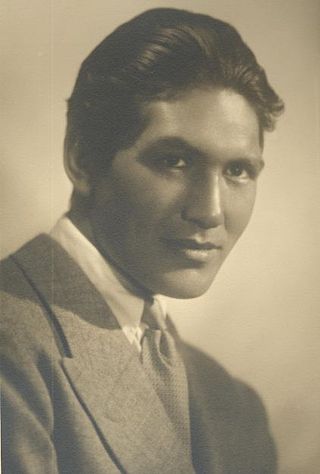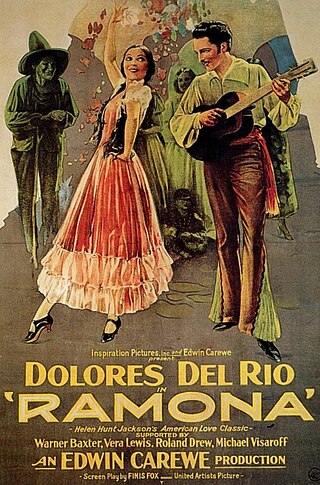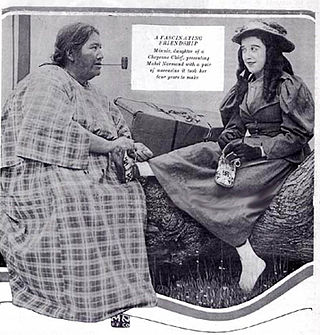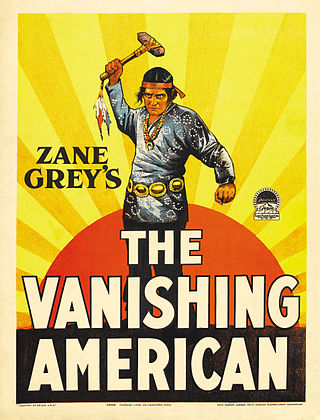
Broken Arrow is a 1950 American revisionist Western film directed by Delmer Daves and starring James Stewart, Jeff Chandler, and Debra Paget. The film is based on historical figures, but fictionalizes their story in dramatized form. It was nominated for three Academy Awards, and won a Golden Globe Award for Best Film Promoting International Understanding. Film historians have said that the film was one of the first major Westerns since the Second World War to portray Native Americans sympathetically.

The Squaw Man is a 1914 American silent Western film directed by Cecil B. DeMille and Oscar C. Apfel, and starring Dustin Farnum. It was DeMille's directorial debut and one of the first feature films to be shot in what is now Hollywood.

Josephine M. Workman better known by her stage name, Princess Mona Darkfeather was an American actress who starred in Native American and Western dramas. During the silent era of motion pictures, from 1911 to 1917, she appeared in 102 movies. She is best known for her role as Prairie Flower in The Vanishing Tribe (1914).

Fred J. Balshofer was a pioneering silent film director, producer, screenwriter, and cinematographer in the United States.
Edendale is a historical name for a district in Los Angeles, California, northwest of Downtown Los Angeles, in what is known today as Echo Park, Los Feliz and Silver Lake. In the opening decades of the 20th century, in the era of silent movies, Edendale was known as the home of most major movie studios on the West Coast. Among its many claims, it was home to the Keystone Cops, and the site of many movie firsts, including Charlie Chaplin's first movie, the first feature-length comedy, and the first pie-in-the-face. The Edendale movie studios were mostly concentrated in a four-block stretch of Allesandro Street, between Berkeley Avenue and Duane Street. Allesandro Street was later renamed Glendale Boulevard.

Ray Mala was a prominent Alaska Native actor. He was one of Hollywood's Native American movie actors along with Lillian St. Cyr, Jesse Cornplanter, Chief Yowlachie, William Eagle Shirt, and Will Rogers who also had successful careers during that time. Mala's career peaked in the 1930s and he was best known for his lead role in Republic Pictures' 14-part serial Robinson Crusoe of Clipper Island (1936) following his feature role in MGM's Eskimo, directed by Woody Van Dyke. He was named a "Top Ten Alaskan" by TIME Magazine in 2009.

Frank E. Montgomery was an early American silent film director and actor.

Eskimo is a 1933 American Pre-Code drama film directed by W. S. Van Dyke and released by Metro-Goldwyn-Mayer (MGM). It is based on the books Der Eskimo and Die Flucht ins weisse Land by Danish explorer and author Peter Freuchen. The film stars Ray Mala as Mala, Lulu Wong Wing as Mala's first wife Aba, Lotus Long as Mala's second wife Iva, Peter Freuchen as the Ship Captain, W. S. Van Dyke as Inspector White, and Joseph Sauers as Sergeant Hunt.

James Young Deer, also known as J. Younger Johnson or Jim Young Deer, was actually born James Young Johnson in Washington, D.C. Although he was identified in the early Hollywood trade paper Moving Picture World as of the Winnebago Tribe of Nebraska, his ancestry is of the Nanticoke people of Delaware. He became an early film actor, director, writer, and producer. He is believed to be the first Native American filmmaker/producer in Hollywood. Together with his wife and partner Lillian St. Cyr, Winnebago, the couple were labeled an "influential force" in the production of one-reel Westerns during the first part of the silent film era. Their films, along with several others of the silent era, were notable for portraying Native Americans in a positive light.

Ramona is a 1928 American synchronized sound drama film directed by Edwin Carewe, based on Helen Hunt Jackson's 1884 novel Ramona, and starring Dolores del Río and Warner Baxter. While the film has no audible dialogue, it was released with a synchronized musical score with sound effects using both the sound-on-disc and sound-on-film process. This was the first United Artists film to be released with a recorded soundtrack. The novel had been previously filmed by D. W. Griffith in 1910 with Mary Pickford, remade in 1916 with Adda Gleason, and again in 1936 with Loretta Young.

Minnie Devereaux was an American silent film actress. She was a member of the Cheyenne and Arapaho Tribes in Oklahoma. More commonly known as Minnie Provost and occasionally "Indian Minnie", or "Minnie Ha-Ha", she held at least 14 roles, beginning in 1913 with Old Mammy’s Secret Code and ending with the 1923 release of The Girl of the Golden West. A few sources say she was a Cheyenne and the daughter of a Chief Plenty Horses. However, her father is often confused with Plenty Horses who was Lakota and born the same year as Minnie. In a 1917 interview published in the Mack Sennett Weekly Provost states that she was born to Cheyenne parents who fled G. A. Custer's Army during the Battle of the Little Bighorn, an event that took place when she was eight years old.

Red Wing was an American actress of the silent era. She and her husband James Young Deer have been dubbed by some as one of the first Native American Hollywood "power couple(s)" along with Mona Darkfeather and her actor/director husband Frank E. Montgomery. St. Cyr was born on the Winnebago Reservation in Nebraska.

The portrayal of Native Americans in television and films concerns indigenous roles in cinema, particularly their depiction in Hollywood productions. Especially in the Western genre, Native American stock characters can reflect contemporary and historical perceptions of Native Americans and the Wild West.

The Vanishing American is a 1925 American silent Western film produced by Famous Players–Lasky and distributed through Paramount Pictures. The film was directed by George B. Seitz and starred Richard Dix and Lois Wilson, recently paired in several screen dramas by Paramount. The film is based on the 1925 novel The Vanishing American by Zane Grey. It was remade as a 1955 film starring Scott Brady and Audrey Totter.

Braveheart is a 1925 American silent contemporary Western film directed by Alan Hale Sr. and starring Rod La Rocque. The story focuses on members of a tribe of Indians who are being intimidated by the owners of a canning company seeking to violate a treaty protecting the tribe's fishing grounds. Braveheart is a remake of the 1914 film Strongheart directed by James Kirkwood Sr. and produced by the American Mutoscope and Biograph Company.
Across the Plains is a 1911 American silent Western film directed by Broncho Billy Anderson and Thomas H. Ince and starring Anderson.

The Daughter of Dawn is a 1920 American silent Western film. It is 83 minutes long and is one of few silent films made, along with In the Land of the Head Hunters and Before the White Man Came (1920), with an entirely Native American cast.

Hiawatha is a 1913 American silent drama film directed by Edgar Lewis and based upon Henry Wadsworth Longfellow's epic poem The Song of Hiawatha (1855). The film stars Jesse Cornplanter of the Seneca people and Soon-goot, a 17-year-old unknown actress. The movie is the first feature film to use a cast of Native Americans.

Richard Davis Thunderbird was a Native American actor of Cheyenne descent known as Chief Thunderbird. He appeared in twenty films but was credited only in major films such as Wild West Days (1937), For the Service (1936), Silly Billies (1936), Custer's Last Stand (1936), Annie Oakley (1935), Cyclone of the Saddle (1935), Laughing Boy (1934), and Heroes of the West (1932).
Reliance Film Company (1910–1915) was an early movie production studio in the United States. It was established in 1910 in Coney Island by Adam Kessel Jr. and Charles O. Baumann.

















